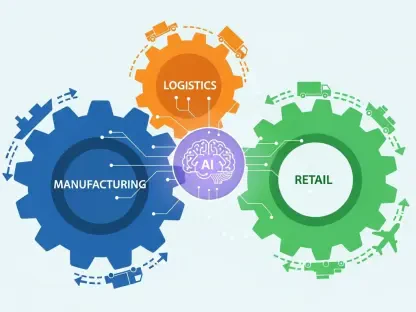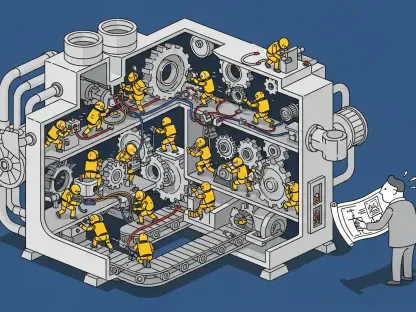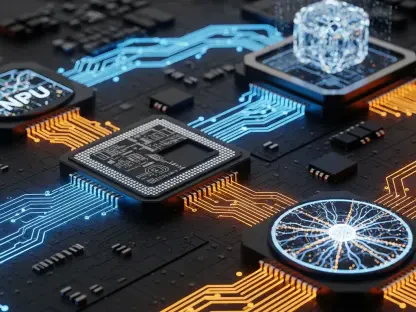In an era where seamless interaction between humans and machines is becoming the backbone of industrial and consumer environments, the demand for sophisticated Human-Machine Interface (HMI) systems has never been higher. Imagine a factory floor where equipment not only operates autonomously but also communicates real-time insights through vivid graphics and intelligent analytics, or a medical monitor that instantly processes complex data to assist in critical decisions. This vision is now closer to reality with the introduction of a groundbreaking microprocessor unit (MPU) by Renesas Electronics Corporation. Designed to meet the escalating needs of advanced HMI applications across sectors like factory equipment, retail terminals, and building automation, this new solution promises to redefine performance standards by integrating cutting-edge processing power and artificial intelligence (AI) capabilities directly at the edge.
Cutting-Edge Technology for Modern Interfaces
Powerhouse Performance with AI Integration
At the heart of this innovative MPU, known as the RZ/G3E, lies a quad-core Arm Cortex-A55 processor running at up to 1.8GHz, complemented by a Cortex-M33 core for real-time tasks. What sets this device apart is the inclusion of an Ethos-U55 Neural Processing Unit (NPU), specifically engineered to handle AI workloads such as image classification, object recognition, and anomaly detection with remarkable efficiency. This architecture ensures that the CPU is relieved of intensive AI processing, allowing for smoother operation in demanding HMI environments. The ability to support Full HD video at 60fps on two independent displays further enhances its appeal, making it ideal for applications requiring high-quality visual output. With versatile interfaces like LVDS, MIPI-DSI, and parallel RGB, the RZ/G3E offers flexibility for developers crafting next-generation interfaces that prioritize both functionality and user experience in industrial and consumer settings.
Beyond its raw processing power, the RZ/G3E excels in enabling vision-based systems through a MIPI-CSI camera interface that facilitates video input for sensing applications. This feature is crucial for scenarios where real-time visual data is paramount, such as in medical monitoring or automated retail solutions. The MPU’s design reflects a deep understanding of the need for integrated solutions that combine AI-driven insights with high-fidelity graphics. By embedding these capabilities into a single chip, Renesas has created a platform that not only meets current market demands but also anticipates future challenges in creating responsive and intelligent HMI systems. This forward-thinking approach ensures that developers have access to tools that can handle complex tasks without compromising on speed or visual clarity, paving the way for more intuitive machine interactions across diverse industries.
Edge Computing and Connectivity Features
A defining characteristic of the RZ/G3E is its emphasis on edge computing, a trend that continues to gain traction as industries seek to process data closer to the source. Equipped with high-speed communication interfaces such as PCI Express 3.0, USB 3.2 Gen2, and dual-channel Gigabit Ethernet, this MPU ensures seamless integration with cloud services, high-speed storage, and even 5G modules. Such robust connectivity is essential for real-time data analytics, a critical component in modern industrial environments where latency can impact efficiency. By bringing powerful processing and connectivity to the edge, the RZ/G3E enables systems to respond instantly to changing conditions, reducing reliance on distant servers and enhancing overall operational reliability in settings ranging from factory floors to smart building systems.
Additionally, the strategic incorporation of the Ethos-U55 NPU, which is also featured in other Renesas products, underscores a commitment to scalable AI solutions across their portfolio. This shared technology approach allows for consistency in development and deployment, making it easier for engineers to adapt the MPU to various applications. The high-speed interfaces cater to the growing need for devices that can handle large volumes of data without bottlenecks, ensuring that edge devices remain competitive in an increasingly connected world. As industries continue to prioritize localized data processing, the RZ/G3E stands as a testament to how advanced connectivity and AI can converge to create smarter, more responsive HMI systems that meet the nuanced demands of today’s technological landscape.
Ecosystem Support and Efficiency Innovations
Power Management for Sustainable Operation
Energy efficiency remains a cornerstone of the RZ/G3E’s design, addressing the industry-wide challenge of balancing high performance with low power consumption. Building on advancements from previous generations, this MPU achieves impressively low power usage, with standby mode consuming around 50mW and deep standby at just 1mW. Even in these low-power states, sub-CPU operations and peripheral functionalities remain active, ensuring that critical tasks are not interrupted. The support for DDR self-refresh mode preserves memory data, enabling rapid wake-up for Linux-based applications. This focus on power conservation is particularly vital for always-on edge devices in industrial settings, where sustainability and operational uptime are equally important considerations for long-term deployment.
Moreover, the power management features of the RZ/G3E reflect a broader industry consensus on the need for energy-efficient solutions that do not sacrifice performance. By optimizing power usage, the MPU extends the lifespan of devices and reduces operational costs, making it an attractive option for sectors like building automation and medical equipment, where reliability is non-negotiable. This careful balance of power and performance ensures that the RZ/G3E can support continuous operation in demanding environments without overheating or excessive energy drain. Such innovations highlight how technological advancements can align with environmental goals, offering a blueprint for future HMI systems that prioritize both efficiency and effectiveness in equal measure.
Robust Software and Partner Ecosystem
The RZ/G3E is backed by a comprehensive software ecosystem that enhances its versatility for developers across various platforms. Renesas provides the Verified Linux Package (VLP) based on the Civil Infrastructure Platform, guaranteeing over a decade of maintenance support, alongside compatibility with the latest LTS kernel and Yocto through Linux BSP Plus. This extensive software support extends to open-source operating systems like Ubuntu and Debian, broadening its applicability for server and desktop environments. Such robust backing ensures that developers can rely on a stable and secure foundation when building complex HMI applications, reducing time-to-market and mitigating risks associated with software integration in diverse use cases.
Complementing this software framework, Renesas has fostered collaborations with ecosystem partners to deliver System-on-Module (SoM) solutions in formats like SMARC and OSM modules. These partnerships simplify the integration of the RZ/G3E into a wide array of applications, from industrial automation to consumer-facing terminals. By leveraging these collaborative efforts, developers gain access to pre-configured solutions that streamline the design process and ensure compatibility with existing systems. This ecosystem approach not only enhances the MPU’s adaptability but also positions it as a scalable platform for future innovations, reflecting a strategic vision to support the evolving needs of HMI technology through sustained collaboration and comprehensive resources.
Reflecting on a Milestone in HMI Evolution
Looking back, the launch of the RZ/G3E MPU by Renesas Electronics Corporation marked a pivotal moment in the advancement of HMI systems. Its blend of high-performance processing, AI acceleration, and energy-efficient design addressed critical industry needs with precision. For developers and engineers, the next steps involved exploring how this technology could be tailored to specific applications, leveraging its robust software support and partner ecosystem to drive innovation. Future considerations included scaling these capabilities to meet emerging demands in real-time analytics and edge computing, ensuring that HMI systems continued to evolve in responsiveness and intelligence. This release set a benchmark for integrating complex functionalities into a single platform, offering a clear path forward for creating smarter, more connected interfaces across industrial and consumer landscapes.









